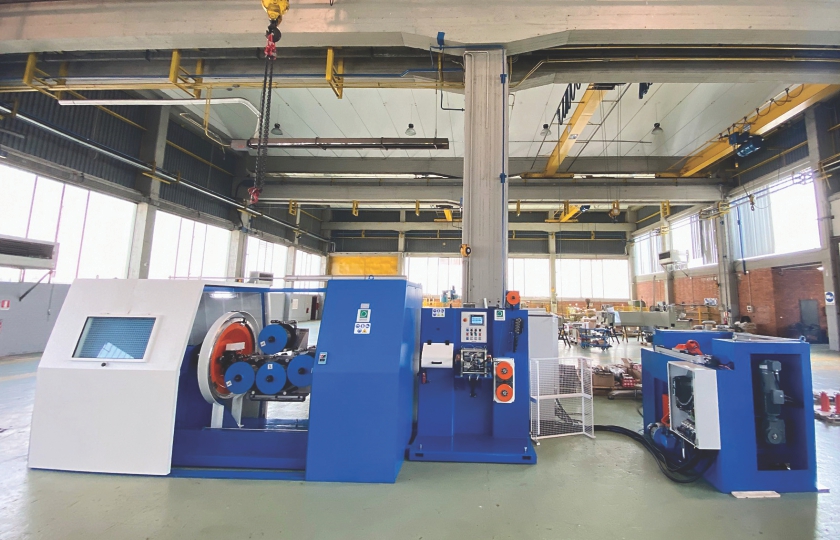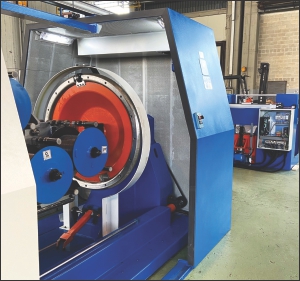The industry has never been under so much pressure as in the prevailing situation. So, improving the efficiency of a production plant has become absolutely necessary in order to maintain competitivity. For the production of steel ropes, the same applies; and the new technologies available can dramatically improve efficiencies, slash production cost and increase safety.
At Eurodraw Wire Equipment, we have always been focused on the development of highly efficient stranding machines, bunchers and closers. Stranding machines can be classified as IN-OUT or OUT-IN type, which means that the payoff spools are inside the cradle and the strand is collected outside the machine, or vice versa. Within the Eurodraw product range, we propose OUT-IN type models which are DTU and DTS machines and IN-OUT models which are DT and CTR machines. Finally, we have the DTA model which is our double twist closer. CTR machines instead are the larger tubular closers.
The common availability of excellent steel qualities and the consistent ductility of the wires make them perfectly suitable to be used on highly efficiently double twist bunchers or standers.Tubular machines have always been the standard in the roping industry, but they are quite slow, noisy, not very safe and require significant power. Furthermore, reloading and adjusting is complicated in order to achieve consistently high-quality products. Although tubular machines have limitations, these are still required to be used as closers for the larger sizes of ropes above 13 mm as no efficient alternative is available.
The quality of steel and drawn wires are steadily improving year by year, so the absence of embedded defects in the steel allows to draw wires at higher speeds, to a higher tensile and to smaller diameters while maintaining a good ductility.
The common availability of excellent steel qualities and the consistent ductility of the wires make them perfectly suitable to be used on highly efficiently double twist bunchers or standers. For this reason, double twist machines are now becoming more and more popular in the industry.
Starting from elementary strand constructions (1+6), our DT (1+6)/400 machine is an unmatched replacement for an equivalent spool size tubular strander, as it runs at more than double the speed, it occupies half the space, it does not require foundations, halves the loading time, and its adjustment is simple and easy. Furthermore, it requires one third of the power to be operated and makes a much better quality of strand.
The space of one tubular machine would be sufficient for installing DT lines, making 4 times the amount of strand and using only a total 60 percent of the power that would be consumed by the line to be replaced. All that can be operated by the same person, as no additional workforce is required even if the machines are two. This alone is an efficiency improvement of 400 percent which is particularly evident on elementary strand sizes from 1 to 2.50 mm in diameter.
DTU machines are designed to make more complex ropes up to 38 wires in various constructions, and as they are OUT-IN machines, they can be loaded with spools up to 800 Kg capacity, each allowing extra-long running time. The wire tensioning system can be either fully electronic or with our unique mechanical brake system. Electronic brake control allows to set the tension of each wire from the machine touch screen and maintain the exact same tension on every wire throughout the bobbin with a click. No time is lost on settings, long uninterrupted runs and high speeds make another massive gain in production efficiency.
Once the elementary or more complex strands are produced, these may be used to be further assembled in other more complicated ropes that could be made on our DTA 900 machines, if the overall rope diameter remains within 10 mm or on our DTA 1250, suited for strands up to 13 mm.
The DTA machine is a unique closer that has incredible advantages compared to a traditional tubular closer. The DTA model is an IN-OUT-IN type of machine, so the elementary strands are unwound each from a rotary back-twisting payoff and then assembled and recollected on a double twist take-up. All this at 2,200 twist per minute, which is an unimaginable speed for a comparable 900 mm spool size tubular machine. Here too, like the DT (1+6) machine, space requirements are far less, no foundations, safe operation and most important, absolute and unmatchable product quality.
But why the quality of ropes made on the double twist machines is generally much better than the ones made on an equivalent tubular machine? One parameter that is key for obtaining an optimum quality rope is a constant tensioning of the filaments composing the rope. A tubular machine, especially the one with many spools, requires that the wire from the last spools travels to the front of the machine by passing through many pipes and guides in order to reach the cabling point. The same applies to all the other spools till the spool that is located just before the cabling die.
Investing in the double twist technology has proven that it is the only way to pursue to dramatically improve a wire rope production plant’s efficiency.When the tube starts to rotate, the wires traveling through the tube are each subject to a centrifugal force which increases the friction created by the guides hence increasing the tension of the wire at the cabling point. As every wire needs to travel a different length to reach the cabling point, the tension to be measured at the cabling point is different for every wire. In order to correct this problem, the brakes of each spool need to be set differently to compensate for the friction. However, this setting is valid only at a particular speed, because if the speed is increased or reduced, friction changes and the settings need to be totally readjusted.
On a double twist machine, there is no tube to travel through and the wires are directly going from the payoff spool to the cabling die without passing through guides and without being subject to any centrifugal force. The strand is formed before going on the flyer of the strander, so all the wires together, in the form of the final strand, are subject to the same identical centrifugal force. The tensioning of the wires is much easier as the setting of the payoffs is generally the same on all positions.
Finally, one last word on power consumption and safety. The mass that moves on a tubular machine is substantial and requires a lot of power to be rotated. A double twist machine has only a light flyer that weighs only few kilograms, hence requiring a fraction of the power to be rotated. Since only the strand is put in rotation, no dangers are present, no chances of spools to be ejected from the tube; the worse that could happen is a strand breakage, but since the machine is fully enclosed into a soundproof cabinet, such an event would not harm anyone.
Investing in the double twist technology has proven that it is the only way to pursue to dramatically improve a wire rope production plant’s efficiency. Replacing tubular stranders with DT (1+6) machines has a dramatic positive impact on the overall cost of the strand, and such an investment pays back in just a few months.






